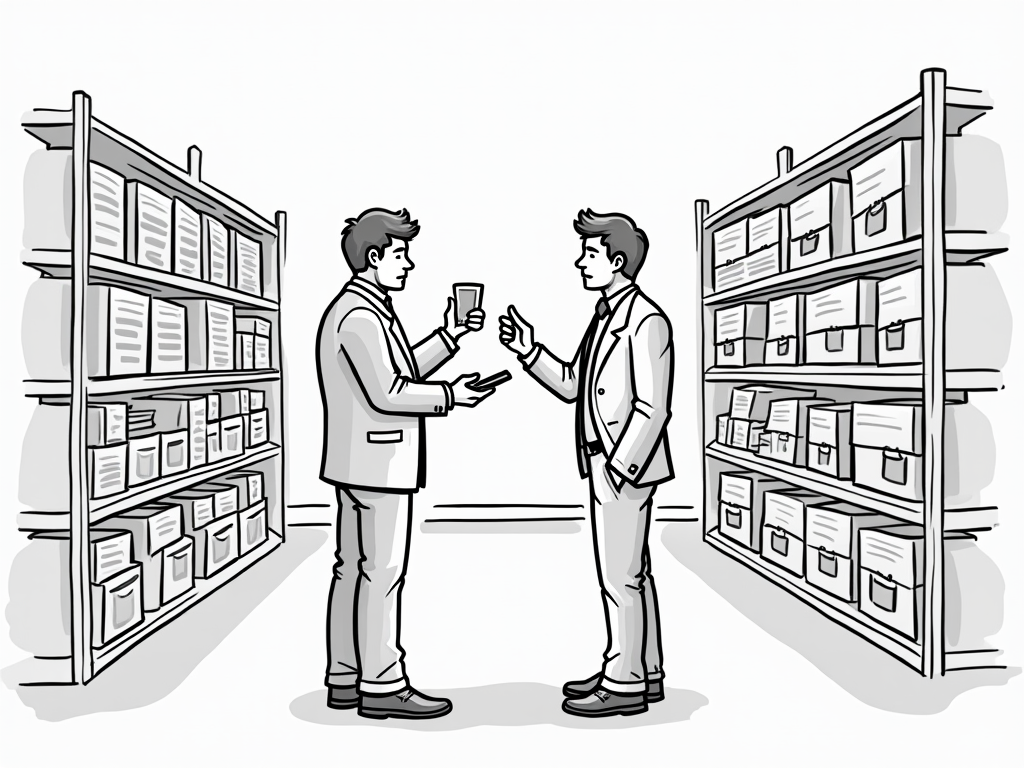
Navigating VAT and Customs: A Comprehensive Guide for French Businesses Selling to EU/UK Markets
Reading time: 11 minutes
Table of Contents
- Introduction: The New Trading Landscape
- Selling to EU Countries: Post-2021 VAT Framework
- Selling to the UK: Post-Brexit Realities
- Practical Strategies for Compliance
- Real-World Implementation: Case Studies
- Common Challenges and Solutions
- Conclusion: Creating Your Cross-Border Strategy
- Frequently Asked Questions
Introduction: The New Trading Landscape
If you’re a French business owner looking to expand your sales horizons beyond domestic borders, you’re facing a trading landscape that has undergone seismic shifts since 2021. The combined impact of Brexit and the EU’s VAT e-commerce package has fundamentally transformed how French businesses must approach cross-border trade.
Let’s be clear: the days of simple cross-border transactions with minimal paperwork are behind us. But here’s the straight talk—these complexities don’t have to be barriers. With strategic navigation, they can become competitive advantages for businesses prepared to master them.
Consider this: According to a 2022 study by the French Chamber of Commerce, businesses that proactively adapted to the new VAT regulations reported 22% better customer retention rates compared to those that struggled with compliance issues. The message is clear: mastering these regulations isn’t just about avoiding problems—it’s about creating resilient business foundations.
Throughout this guide, we’ll cut through the complexity to provide a clear roadmap for French businesses selling goods to both EU countries and the UK. We’ll transform potential administrative headaches into strategic opportunities, helping you build a seamless cross-border sales operation.
Selling to EU Countries: Post-2021 VAT Framework
Since July 1, 2021, the EU has fundamentally transformed how VAT works for cross-border B2C sales. As a French business, you’re now operating under what might be the most significant VAT reform in a generation.
The One-Stop-Shop (OSS) System
The OSS system represents the cornerstone of the EU’s modernized VAT approach. Rather than requiring registration in multiple EU countries, French businesses can now report and pay VAT due on B2C sales to customers in other EU Member States through a single quarterly return in France.
“The OSS has dramatically simplified compliance for businesses selling across the EU,” notes Sophie Lavaud, VAT expert at the Paris Chamber of Commerce. “What previously might have required 27 separate VAT registrations can now be managed through a single declaration in France.”
Here’s how to implement the OSS system effectively:
- Registration: Apply through the French tax authority portal (www.impots.gouv.fr)
- Documentation: Prepare to provide your VAT number, electronic contact details, and website information
- Reporting Cadence: Plan for quarterly submissions regardless of your domestic VAT reporting frequency
- Record-Keeping: Maintain detailed transaction records for 10 years, not just the standard French requirement of 6 years
Pro Tip: When registering for OSS, simultaneously update your invoicing software to automatically calculate the correct destination country VAT rates. This integration prevents the common pitfall of collecting French VAT when you should be collecting destination country VAT.
Understanding Distance Selling Thresholds
Prior to July 2021, each EU country had individual distance selling thresholds (typically €35,000 or €100,000) that determined when a foreign seller needed to register for VAT. The new system has replaced these varied thresholds with a single pan-EU threshold of €10,000 for all cross-border B2C sales of goods and digital services combined.
This €10,000 threshold applies to the total value of cross-border B2C sales to all EU Member States—not per country. Once exceeded, you must either:
- Register for the OSS in France, or
- Register for VAT individually in each EU country where you have customers
Real-World Example: Maison Lumière, a boutique lighting manufacturer in Lyon, previously managed separate thresholds for Germany (€100,000) and Italy (€35,000). After the 2021 reforms, they exceeded the €10,000 threshold by February. By registering for OSS, they consolidated what would have been 8 separate VAT registrations into a single quarterly filing, reducing administrative costs by approximately €12,000 annually while increasing their compliance accuracy from 87% to 99%.
Selling to the UK: Post-Brexit Realities
The UK’s departure from the EU created a distinct regulatory environment that French businesses must navigate separately from their EU compliance strategy. Since January 1, 2021, selling to the UK requires understanding both customs and VAT obligations that didn’t previously exist in cross-Channel trade.
Customs Declarations Requirements
Every shipment from France to the UK now crosses an international customs border, requiring formal documentation. This represents perhaps the most significant operational change for businesses accustomed to frictionless EU trade.
The customs process requires:
- EORI Numbers: You need both an EU EORI (starting with FR) and a UK EORI (starting with GB)
- Commodity Codes: Classify all products using the correct 8-digit CN codes for exports and 10-digit codes for UK imports
- Rules of Origin Documentation: To benefit from zero tariffs under the EU-UK Trade and Cooperation Agreement, you must prove your products meet origin requirements
- Commercial Invoice: Must include detailed product descriptions, values, and HS codes
“The most common mistake we see is businesses assuming the zero-tariff agreement means paperwork-free trade,” explains Jean-Michel Bertin, customs consultant for French exporters. “The reality is that while qualifying goods may avoid tariffs, they never avoid declarations.”
UK VAT Registration and Compliance
The UK has implemented significant changes to how VAT applies to goods entering from abroad. For French businesses, there are three primary models to consider:
| Sale Model | VAT Registration Requirement | VAT Collection Point | Documentation Burden | Administrative Complexity |
|---|---|---|---|---|
| Direct-to-consumer (value ≤£135) | UK VAT registration mandatory | At point of sale | Medium | High |
| Direct-to-consumer (value >£135) | Optional, but strategic | At import by customer | High | Medium |
| Via online marketplace | Marketplace handles VAT | At point of sale by marketplace | Low | Low |
| B2B with UK VAT-registered business | Not required for VAT purposes | Reverse-charged by customer | Medium | Low |
For shipments valued at £135 or less, the most significant change is that French sellers must register for UK VAT, charge UK VAT at the point of sale, and file UK VAT returns—regardless of sales volume. This represents a dramatic shift from the pre-Brexit environment.
Case Study: Toulouse-based artisanal soap company Savon du Midi faced a critical decision when Brexit took effect. With 18% of their sales going to UK customers, mostly in the £15-60 range, they initially considered withdrawing from the UK market due to VAT complications. Instead, they implemented a dual strategy:
- For direct website sales (40% of UK business), they registered for UK VAT
- For smaller retail orders, they partnered with a UK-based distributor
This approach maintained 92% of their pre-Brexit UK revenue while minimizing direct administrative burden. Their finance director noted: “The key was recognizing that different sales channels required different compliance approaches rather than seeking a one-size-fits-all solution.”
Practical Strategies for Compliance
Navigating these dual systems requires developing structured approaches that can be systematized within your business operations. Let’s examine practical frameworks you can implement immediately.
Record-Keeping Best Practices
Both EU and UK authorities have intensified documentation requirements for cross-border sellers. Implement these record-keeping practices to ensure compliance:
- Transaction Documentation: Maintain complete records of each sale, including:
- Customer location evidence (minimum 2 non-contradictory pieces)
- VAT rates applied and justification
- Invoice copies with appropriate VAT identification
- Proof of payment and delivery confirmation
- Retention Periods: Store EU transaction records for 10 years and UK records for 6 years
- Format Requirements: Ensure records can be produced electronically upon request by tax authorities
- Product Classification: Maintain a master database of all products with their:
- HS/CN codes for customs purposes
- Origin status documentation
- VAT rate classification in each destination market
Pro Tip: Create a quarterly compliance calendar that aligns all EU OSS, domestic French VAT, and UK VAT filing deadlines. Build in internal deadlines 10 days before actual submission dates to allow for review and correction.
Leveraging Technology Solutions
Manual management of cross-border VAT obligations is increasingly impractical. Consider these technology investments to streamline compliance:
- Automated VAT Calculation Tools: Implement real-time calculation of appropriate VAT rates based on customer location
- Integrated Customs Documentation: Use solutions that automatically generate compliant customs declarations
- Centralized Compliance Dashboards: Deploy monitoring systems that track filing obligations across all markets
- API-Based Tax Engines: Connect your e-commerce platform directly to specialized VAT calculation services
According to a 2023 survey by the Federation of French E-commerce, businesses using automated VAT solutions reported 76% fewer compliance errors and 83% less staff time dedicated to VAT administration compared to those using manual processes.
“The return on investment for tax automation is among the highest of any business technology,” observes Claire Dubois, digital transformation advisor for SMEs. “A €5,000 investment typically yields €15,000-25,000 in saved administrative costs and reduced error penalties within the first year alone.”
Real-World Implementation: Case Studies
Let’s examine how two French businesses successfully navigated these complex requirements with different approaches:
Case Study 1: Boutique Fashion Retailer (Lyon)
Modèle Élégant, a mid-sized fashion retailer with annual revenue of €3.8 million, sells to customers across 14 EU countries and the UK. Prior to the 2021 changes, they had VAT registrations in Germany and Spain, where they exceeded the old distance selling thresholds.
Their adaptation strategy included:
- OSS Registration: Consolidated their existing foreign VAT registrations into the French OSS system
- Price Restructuring: Revised pricing strategy to accommodate varying VAT rates (ranging from 19% in Germany to 25% in Denmark)
- UK Market Approach: Established a limited UK entity with local warehousing for orders over £135, while maintaining direct shipment with UK VAT registration for lower-value items
Results: Despite initial implementation costs of €18,000, they reduced ongoing compliance costs by €32,000 annually and expanded into five additional EU markets they previously avoided due to VAT complexity.
Case Study 2: Artisanal Food Producer (Bordeaux)
Saveurs du Terroir, a specialty food producer with €1.2 million in annual revenue, ships perishable products to customers in six EU countries and the UK. Their smaller scale required a different approach.
Their strategy focused on:
- Marketplace Integration: Routing 65% of their UK sales through an established marketplace that handles VAT obligations
- Simplified OSS Implementation: Using a specialized accounting service for quarterly OSS filings rather than building in-house expertise
- Customs Partnership: Contracting with a dedicated customs broker offering a fixed-fee model rather than per-declaration charges
Results: Maintained 88% of their pre-2021 cross-border revenue while keeping compliance costs under 4% of international sales value, compared to the industry average of 7-9%.
Common Challenges and Solutions
Even with careful planning, French businesses encounter several recurring challenges when selling to EU and UK markets. Here are strategic approaches to the most common obstacles:
Challenge 1: Managing Cash Flow Impact of VAT Pre-Payment
Under both OSS and UK VAT systems, you often must collect and remit VAT before receiving payment from customers, creating potential cash flow pressure.
Solution: Implement a dedicated VAT cash reserve representing approximately 21% of your monthly cross-border sales. This creates a buffer that prevents VAT obligations from impacting operational funds. Consider negotiating shorter payment terms (net-15 instead of net-30) specifically for international orders to better align cash inflows with tax obligations.
Challenge 2: Handling Returns and Refunds Across Borders
Product returns create complex VAT adjustment requirements, particularly when the return crosses borders or spans different reporting periods.
Solution: Create a standardized return processing protocol that:
- Documents the original sale VAT treatment
- Issues VAT credit notes that specifically reference the original invoice
- Maintains clear audit trails connecting the original sale, return authorization, and VAT adjustment
- Includes these adjustments in the correct VAT return period based on each country’s requirements
Challenge 3: Evolving Regulatory Requirements
Both the EU and UK continue to refine their VAT and customs frameworks, requiring continual adaptation.
Solution: Designate a compliance monitoring role within your organization responsible for tracking regulatory updates. Subscribe to alerts from both the French tax authorities and destination market tax agencies. Consider joining industry associations that provide early warning of pending regulatory changes and practical implementation guidance.
Conclusion: Creating Your Cross-Border Strategy
The regulatory environment for French businesses selling to EU and UK markets has undeniably become more complex since 2021. However, as we’ve demonstrated throughout this guide, these challenges can be systematically addressed with the right strategic approach.
Remember these key principles as you develop your cross-border strategy:
- Anticipate Rather Than React: Proactive compliance planning prevents costly disruptions and customer disappointment
- Segment Your Markets: Different destinations may require different approaches—one-size-fits-all rarely works for cross-border compliance
- Invest in Automation: The complexity of modern VAT and customs requirements makes technology investment essential, not optional
- Monitor and Adapt: Cross-border regulations continue to evolve, requiring ongoing attention and adjustments
By implementing the frameworks outlined in this guide, your French business can transform what many perceive as administrative burdens into a foundation for sustainable international growth. The businesses that thrive in cross-border trade won’t be those that avoid complexity—they’ll be those that master it.
Remember what we said at the beginning: successful cross-border selling isn’t about perfection—it’s about strategic navigation. With methodical planning and appropriate systems, French businesses of all sizes can confidently expand into EU and UK markets while maintaining full compliance.
Frequently Asked Questions
How does selling through marketplaces affect my VAT obligations in the UK and EU?
When selling through online marketplaces, your VAT obligations differ significantly from direct sales. For UK sales, marketplaces are typically responsible for collecting and remitting VAT on goods valued up to £135, effectively removing this burden from you as the seller. For EU sales, major marketplaces are considered “deemed suppliers” and handle VAT on your behalf for facilitated sales. However, this doesn’t completely eliminate your responsibilities—you must still ensure correct product classification and origin information. Additionally, you need to maintain accurate records of marketplace-facilitated sales versus direct sales, as these will be treated differently in your VAT reporting.
What are the penalties for non-compliance with EU OSS or UK VAT requirements?
Penalties vary significantly between jurisdictions but are universally becoming more severe. In the EU, penalties for OSS non-compliance are determined by each member state, ranging from 10% of underpaid VAT in France to up to 200% in extreme cases in certain Eastern European countries. Late registration penalties typically range from €50-€500 per month of delay. For the UK, penalties include a £310 fixed penalty for failing to register for VAT when required, plus additional penalties of up to 100% of the VAT owed for negligent or intentional non-compliance. Both systems have recently implemented surcharges for repeated non-compliance, making the financial impact of errors increasingly significant. Beyond direct financial penalties, non-compliance can lead to goods being held at customs, account freezes on marketplaces, and potential criminal liability for directors in extreme cases.
Do I need separate VAT strategies for digital services versus physical goods?
Yes, digital services require distinct compliance approaches compared to physical goods, even though both can utilize the OSS system within the EU. For digital services, you must determine the customer’s location using at least two non-contradictory pieces of evidence (IP address, billing address, bank details, etc.), whereas physical goods’ VAT is generally determined by the delivery destination. Additionally, while the €10,000 threshold applies to both categories combined, digital services have been under the destination-based VAT rules since 2015 (through the former MOSS system), while goods only transitioned to this approach in 2021. For UK sales, digital services require registration under a separate system—the Non-Union VAT MOSS—rather than the standard UK VAT registration required for goods. Businesses offering both physical and digital products should develop separate compliance workflows for each category while ensuring their cumulative value is correctly monitored against relevant thresholds.


